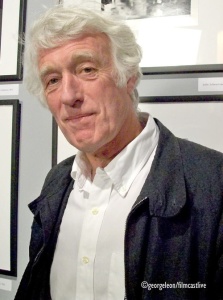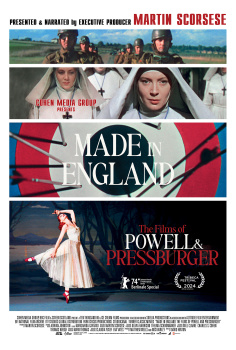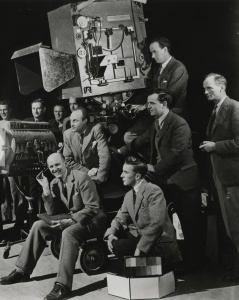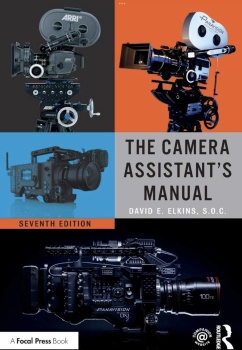with Peter Bogdanovich

Peter: Well, it is incredible. I don't know how the hell you did it. That was your first movie as a director for a commercial release. And then you made five or six pictures right one after the other...
Jerry: Yep.
Jerry: Is that when you invented the video assist?
Jerry: 1956. I had already invented the video assist.
Peter: How did you come...how did that happen?
Jerry: So you can see yourself.
Peter: Yeah. Of course.
Peter: Amazing.
Jerry: I used only video monitors. I‘d use 30 or 35 of them on the set. Everywhere I was, I could see where we were when I was shooting and I would either make the entrance or cut it. If it was fine, I'd continue. I'd have all that information wherever I looked. No one could understand how I would know what that meant. Well, you work it out.
My interest into the matter is that grew up admiring and laughing at the nutty slapstick screwball comedy of Jerry Lewis and I still remember seen him directing Smorgasbord back in 1982 on location. Also, I have many years of experience using video assist or video taps as they are commonly known. I used them for music videos and television commercials. But, I never was a fan of the gizmo. It was blessed curse. It was the choice of directors or producers , but not necessarily mine as a cinematographer or camera operator for many obvious reasons.
In light of the conversation between Jerry and Peter and other claims of such technical achievement, Peter Glaskowsky, writer of Speeds and Feeds and technology analyst of CNET News decided to investigate the movie star patent registration.
A few weeks ago, he wrote about Jerry Lewis' role in the development of "video assist" technology, the use of video technology to support film making (see "Jerry Lewis and the elusive Video Assist patent"). Lewis was credited as the inventor of video assist during the Academy Awards telecast in February, and more specifically, was said to hold a patent on the technology. He looked for this patent because he thought it would be interesting to write about it here, but didn't find it. After he contacted the U.S. Patent and Trademark Office for help with the story, it looked too. The bottom line is that there is no such patent.

by Jim Songer for American Cinematographer
magazine, shows a Panavision camera with the
video assist subsystem integrated into the loading door.
(Credit: Jim Songer and Video West)
It turns out that video assist goes back to well before 1956, when Lewis claims to have invented it--as he did in a 2008 interview with Peter Bogdanovich. Thanks to a commenter on my original post, plus some long discussions with Jim Songer, an engineer who made substantial contributions to video assist in the 1960s, I have tracked down what may be the earliest patents on video-assist technology. But before I get into those patents, let me describe the elements of video assist technology in a little more detail. First, video assist relates primarily to motion picture production. As the name suggests, the purpose of the video is to assist the production by allowing the director, actors, and other crew members to review what's being filmed. This can be done live, or if video recording is used, the video can be reviewed after the shot.
The ultimate implementation of video assist requires simultaneous film and video recording of the same scene with the greatest possible quality and convenience. Accordingly, both film and video recording should be accomplished with what amounts to one camera, which should meet all the other requirements for motion-picture principal photography, use the same viewfinder and all of the same controls, and work with the same lenses and lighting. There can still be considerable value to a system that doesn't meet all these requirements. Indeed, the earliest video-assist systems were very simple. US Patent 2,420,197 by Adolph H. Rosenthal, issued in 1947 with a 1944 filing date, describes combining film and video cameras on a common chassis. Each camera used its own lens, which means they couldn't record exactly the same view (a condition known as parallax). Parallax can be a problem, especially for a tightly framed shot. Sometimes it isn't a problem. Lewis, for example, used video assist to help set up the timing of his scenes, so precise framing wasn't essential. From what I've been able to learn, Lewis' original video-assist system used separate video and film cameras, possibly mechanically attached for convenience, and so may have been unpatentable in light of the the 1947 patent.
The next major step was to combine the two optical systems to eliminate the parallax error. This combination was described in U.S. Patent 2,698,356 by Paul Roos, issued 1954 with a 1951 filing date, which describes the combination of a movie camera with a TV camera recording the image through the same lens using a beamsplitter. It appears that the Roos adapted an existing camera design that used the beamsplitter to provide an optical viewfinder; Roos realized he could put a video camera in the viewfinder path. This development earned Roos a 1988 Technical Achievement Award from the Academy of Motion Picture Arts and Sciences (AMPAS) "for the invention of a method known as Video Assist."
A 1955 patent filed in 1953 by Arthur E. Reeves and Robert Gordon Nichols (U.S. 2,709,391) goes one more essential step by adding a second beamsplitter so that both an optical viewfinder and a video camera could be used simultaneously. Songer explained to me a limitation of the Reeves/Nichols design: the three optical paths in this system, each with a different length, would cause undesirable variations in image size. For one lens, the film might see a wider view than the video camera; for another, the image on the film might be larger and thus have a narrower view. Solving this problem would require making significant adjustments to the camera when changing lenses.
Also, since the video camera is so far from the lens, with so many optical elements in between, it would not receive very much light. The video cameras of those days were not extremely sensitive, so to make them work, more light had to be diverted from the film. There are a couple of patents from 1960 and 1965 describing the attachment of a 16mm film camera to a studio-style TV camera, but as far as I can tell, there were no further advances in video assist technology for motion-picture use until Jim Songer integrated a video camera into a Panavision film camera and solved these problems. Songer was hired by Gordon Sawyer of Samuel Goldwyn Studios in 1962 to work on video-assist technology, which he called "Instant Replay" at the time. Over the next several years the path of his developments echoed that of previous efforts, solving each problem in turn. Along the way,
Songer's project was spun out to create a company called "Video West," and Songer was kind enough to send me copies of articles from American Cinematographer magazine describing the "Video West Instant Replay System." Ultimately, Songer designed his own video camera using a high-resolution Saticon tube in which the video image was scanned from only a small portion of the tube face. This made it possible to divert a smaller portion of the light away from the film, so the combined camera system could work with standard studio lighting.
Songer's design made the video camera work as an almost invisible element in the film camera, eliminating the need for adjustments when changing lenses and minimizing the light loss so the camera would still work in typical studio conditions. Songer's design was also more practical for use in the fast-paced motion picture industry than previous systems. It eliminated the need for adjustments when changing lenses, and was built into the loading door for a standard Panavision camera so that it could be moved from one camera to another.
Previous systems, including a competing design from the Mitchell Camera Company, were built into the camera chassis, but Hollywood producers found it more convenient to rent standard cameras and install the video-assist module only when needed. With just two of these video-assist systems, Video West supported the production of a large number of motion pictures starting with Blake Edwards' "The Party." Songer also made his system wireless: the video signal was transmitted by radio to the video-tape recorder and multiple video monitors, including battery-operated portable monitors that could be brought onto the set for review by actors.
Songer received his own Technical Achievement Award from AMPAS for 2002. The research report prepared by AMPAS to support the award states: "...it can be concluded that the development of Video Assist by Jim Songer has had one of the most significant impacts of any technical development in the history of the fim industry." Referring to the various technical requirements for video assist as part of principal cinematography, the report concludes: "Since Jim Songer's Video Assist system was built inside the first sound reflex camera to be accepted by the motion picture industry for a camera in the 'A' position, it would make it chronologically impossible for anyone else to have achieved video assist any earlier."
(Songer didn't apply for patents on this work, which would have belonged to Video West in any event. But later in his career, he earned 17 US patents between 1976 and 2003, plus many more international patents. Some were very significant. One anticipated the Macrovision copy-protection technology for video-cassette recorders, for example. Others related to 3D video display and high-definition TV.) All of this information seems to put an end to Lewis' claims. He was undoubtedly a pioneer in the application of video assist, but others made more significant contributions to the development of this important technology.
Read On the Set with Video Assist by Michael Frediani, SOC



























































